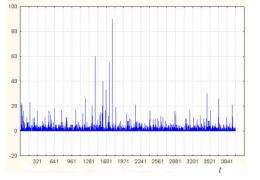May 23, 2012 weblog
Research suggests cells communicate via biophotons

(Phys.org) -- Biologists have long been familiar with luminescence in organisms, where plants and animals produce visible light, but more intriguing perhaps is the newer field of study centered around biophotons, whereby cells in organisms produce photons, but in numbers that are too few to be seen. How they do so and why, is an area that has come under more scrutiny of late. Now, new research by Sergey Mayburov, of the Lebedev Institute of Physics in Moscow, has uncovered a pattern in photons being generated by cells in fish eggs that gives credence to the theory that some cells use biophotons to communicate. He has written a paper describing his results and has posted it on the preprint server arXiv.
Mayburov is not alone in his thinking. Other researchers have found what they believe to be evidence of cells communicating by emitting streams of biophotons. Some have even have found what they believe are associations between the emittance of biophotons and increased cell division in plants growing in close proximity; so much so that they have measured increases of up to 30%. Others have found that biophotons emitted from older eggs in a clutch, appear to inhibit the growth of immature eggs; a form of survival of the fittest, or at least the more mature.
To find out if fish eggs are able to play a similar role, Mayburov turned out the lights in his lab and recorded biophotons as they were emitted from the eggs. His aim was to see if any discernible pattern could be found, which would perhaps offer some clues as to how biophotons could be used by organisms or their cells to communicate. After much study, he says he has indeed found such a pattern and that it resembles the way we humans send binary data over noisy communications channels. The biophotons he studied he says, emit near periodic bursts of photons which could conceivably be seen and interpreted by other organisms or their cells who could then respond accordingly.
Mayburov’s results don’t really prove anything of course, his results are purely speculative, yet they do suggest that there might be more to biophotons than has been previously thought. More work will have to be conducted to find answers to the many questions that still exist, such as how do cells actually create them, and if other cells in other organisms are really listening, how do they do it, and perhaps more importantly, how do they know how to respond to them?
More information: Photonic Communications and Information Encoding in Biological Systems, arXiv:1205.4134v1 [q-bio.OT] arxiv.org/abs/1205.4134
Abstract
The structure of optical radiation emitted by the samples of loach fish eggs is studied. It was found earlier that such radiation perform the communications between distant samples, which result in the synchronization of their development. The photon radiation in form of short quasi-periodic bursts was observed for fish and frog eggs, hence the communication mechanism can be similar to the exchange of binary encoded data in the computer nets via the noisy channels. The data analysis of fish egg radiation demonstrates that in this case the information encoding is similar to the digit to time analogue algorithm.
via Arxiv Blog
Journal information: arXiv
© 2012 Phys.Org
















